Jugendstil in Prague (Praha)
General
presentation
I would like to let you see my 7
favorite Art Nouveau
buildings in Prague. If you are interested to carry on such a visit,
you should know that there is much more to see. The Art
Nouveau/Jugendstil period (1898-1914) has seen tremendous builders.
Some whole areas of the town were designed in the Art
Nouveau/Jugendstil style. Once you are out of the inner center of the
town, you will see that the general state of the buildings is painful.
The broken window panes, the tumbledown plaster, the Art Nouveau door
handles replaced by standard ones... are certainly due to the communist
inheritance. On the other hand there haven't been
destruction/reconstruction programs as in western Europe so nearly all
the original Art Nouveau buildings are up.
Art Nouveau apart,
you should also have a romantic walk across the Vlata on Charles'
bridge, see the great astronomical clock (which is unique in Europe
apart the one in Strasbourg in France), the rectangle stone towers,
part of the ancient city wall, with their typical steep slated roof and
their 4 peaks in the angles. On the other hand, if you enjoy Classical
Music, you will soon be charmed by Prague. There is a concert in every
church every day.
Prague in 1900
Situation
Till 1918, Prague was part of the Austro-Hungarian empire
and nowdays it is the head city of the Czech
republic, but from the second half of the XIXth century, a
lot of independence movements have risen. These voices claimed not only
a political autonomy but also a cultural one.
Geographically,
Prague was not as large of today, a lot of AN buildings that are today
in Prague were in fact in other little independent towns like Smichov.
The Prague of today was created in 1922. As nearly all large towns of
that time in Europe, Prague grew at high speed. The period is
contemporary to fast rural depopulation combined with start of
industry. All the city walls were razed during the second half of the
century.
Architecture

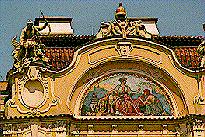 The
main architects are Ohmann (1858-1927), Bendelmeyer (1872-1932)
and Kotera (1871-1923). The fate of Mucha (1860-1939), alike Czech, is
indissociable of
his meeting with Sarah Bernhard in
Paris at the turn of the century, but after some time
in the United States, he went back to Prague in 1913 and then he
participated to the
decoration of several buildings. He was an active proponent of a Czech
way for modern art.
The
main architects are Ohmann (1858-1927), Bendelmeyer (1872-1932)
and Kotera (1871-1923). The fate of Mucha (1860-1939), alike Czech, is
indissociable of
his meeting with Sarah Bernhard in
Paris at the turn of the century, but after some time
in the United States, he went back to Prague in 1913 and then he
participated to the
decoration of several buildings. He was an active proponent of a Czech
way for modern art.
If some of the Prague AN artists came from Vienna or have learned in
Vienna schools of
architecture (and especially Otto Wagner's), Czech artists have
developed their proper
way into Art Nouveau If you wander a little around AN buildings in
Prague, you will notice
that Prague AN artists had their favorite decorative pattern: it is a
set of tree
branches with flat and overlapping leaves. (See on the left the picture
of a grave in the Slavin)
My top seven
Hybernska ulice, 10
Ohmann (1899-1902), with Bedrich Bendelmayer, Alois Dryak
| "Hotel
Central" is one of the first AN building in Prague. It is traditionally
built with plastered bricks and stuccos. Its milky mint color is
largely used in Prague. The stucco pattern is inspired by tree leaves.
The lamps, the font used for the hotel name, every detail have been
designed by the architect as a total work of Art. Today, the hotel is
closed, the ground floor is devastated, the brick is bear and giant
placards have been put over the windows. But the rest of the building
will let you imagine some of the splendors of Prague in 1900. |
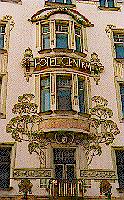 |
Vaclavske namesti, 25
Bendelmayer and Dryak, 1903-06
| "Hotel
Europa" gathers today two hotels. Hotels were a type of building that
used very often the Art Nouveau style. The attention that AN architects
paid to every detail is used efficiently for a luxury and comfort
purpose. These hotels had all the modern conveniences of that time. It
was a way to gain an international shining, and to show the state of
the Art in Prague. The architects designed all the parts of the
building and let some of the best craftsmen realise them, one craftman
for each different material. | 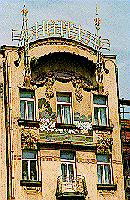 |
Vodickova ulice, 30
Oskar Polivka (1901-04)
| This
building was originally built in 1878 adopting a classical revival
style and then it was turn into Art Nouveau by Polivka to meet public
taste. The metal work of the balconies, the door with stain glasses,
the wall covering mosaic (by Jan Preisler) have been greatly restored. |
 |
Hrad, III nadvori
St Vitus cathedral
was built in gothic revival style and finished in 1912. Two AN features
are visible on the right side of the neve: a stain glass by Mucha and a
wooden Christ on the cross by Bilek. More information about Bilek in
the description of Bilek's house.
Don't forget to see the Nepomucen's chapel and its baroque grave.
Mucha is certainly the most well known Czech AN artist in the world.
His stain glass, designed in 1931, keep still some very good AN
features although the AN period was over. The stain glass represents
"St Cyrillus and Method legend". | 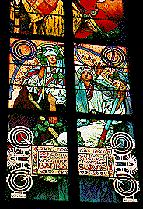
|
namesti Republiky, 5
Arch: Antonin BALSANEK, Osvald POLIVKA, 1903-1905
Mosaic: Karel Spillar
Sculptor: Franta Uprka, Josef Maratka
Inside: CHOCHOL, Balsanek, Saloun, Preisler, Alphons MUCHA,
POLIVKA,..
The
outside is built in a baroque revival style with modern
technics including a large fresco on the front, a copper and glass
dome, a large marquee overtopped by cariatide lights (photo
§5). The inside was designed by the most well
known AN artists. The rooms, named after Czech heroes, have a
decoration inspired by nationalism (example : ceramic fresco in the
underground restaurant on photo §3). You will admire the
Jugendstil hanging lights (example on photo §1). It hosts also
three restaurants
in the building: French Restaurant, Mozart Restaurant and
Café Nouveau (photo §3) and a large concert hall.
Except for the restaurants, it is not possible to visit the building
except for some guided tour, which are not regularly nor often
programmed.
The communal houses, people houses or even national houses are typical
buildings from the AN era. It is part of a
will to make the Arts available for all the inhabitants of the town and
be a show room of national technical and artistic skills. In Prague, it
takes a particular taste regarding the will of independence of the
czech against austrian. The independance arrived in 1918 at the end of
World War 1 (the declaration of independance was made in the building).
The building was restored to its original beauty during the years
1996-97.
| 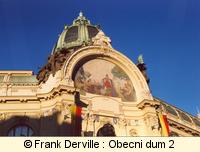 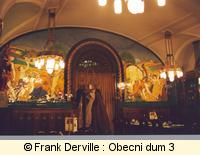 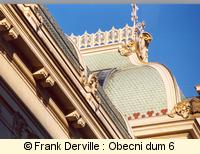 |
 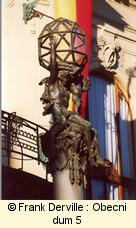 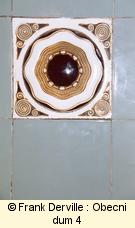 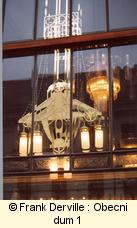 |
8/300, Wilsanova trida
Josef FANTA, architect
Stanislas SUCHARDA, sculptor
1901-1909
The
main station of Prague is built over drive through
plateforms. It has a symetrical shape and at its center a large and
high semi circular hall with two towers (photo §3). Two office
buildings mark the way outs of the railways. The original floor of the
building is below the street level as a highway was constructed in 1970
together with a reconstruction of the central part and the construction
of an underground hall. You can appreciate this in photo §2
with the old and new iron fences at two different levels (the original
ones with floral patterns as a balcony which is now littls below street
level and the new ones on the pavement to avoid people from falling to
the ancient ground level, more geometrical but still with an Art
Nouveau taste, but dating from 1970).
Don't miss inside these
superbs ceramics frescos (photo §4) in the northen wing in
room that is used now as a storage but was a restaurant. Don't miss
either the door of the northern office building with sculpures and
stain glasses (photo §5).
The building is today in a
really bad state (photo §1) and its wonderful Art Nouveau
features are not yet restored. |  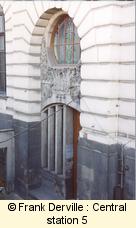 |
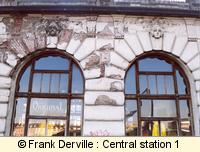 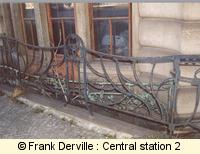  |
9/1010 and 7/1011, Narodni Trida
Osvald POLIVKA 1906 and 1901
Mickiewiczova ulice, 1
Bilek, 1912
| Nowdays, it
is a museum about Bilek's sculpture work. The whole building has been
designed by Bilek from the furniture to the door handles. It is one of
the most surprising building in Prague with its semi carved stones and
bricks. The plan is very original and functional associating a duplex
house part and a one storey workshop/exhibition part. Bilek sculptures
are very mysterious and often show some pain. Though he was not part of
any movement, his work is close to symbolism. | 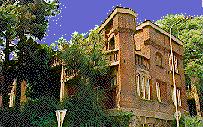 (88K) (88K) |
Villa Henlenka
ulice Na Vaclavce, 30
Alois Korda, 1903
With its
angle tower and floral sgraffito, this villa gathers AN and traditional
features. Although it is the best example of Jugendstil villa near
Prague, it is today very tumbledown.
A sgraffito is a kind of
drawing that is made in the wall cement while it is not yet dry. |
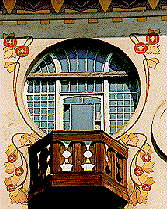
(99K)
| 
(112K) |
Books
| Title/Editor |
Language | Comment | Price |
| 15 promenades dans Prague/ Ed
Casterman, Belgium | French | This
is a guide about architecture in Prague with maps, a thematic
identification, black and white drawings every 2 page, an artist
index... It is "The" guide | 190FF |
| Jugendstil in Prague | Available
in English, French and German | This book written
by Czech authors is full of addresses of AN buildings. The lack of
historical information and general information about AN for a
specialized book is very missing. No map. No index. Not very convenient
for a visit. It is available in every bookshop in Prague | About
400 Kc |

 RSS
RSS

















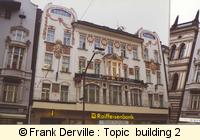



 (88K)
(88K)
